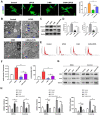Low-Intensity Pulsed Ultrasound Enhances the Efficacy of Bone Marrow-Derived MSCs in Osteoarthritis Cartilage Repair by Regulating Autophagy-Mediated Exosome Release
- PMID: 35438034
- PMCID: PMC9137322
- DOI: 10.1177/19476035221093060
Low-Intensity Pulsed Ultrasound Enhances the Efficacy of Bone Marrow-Derived MSCs in Osteoarthritis Cartilage Repair by Regulating Autophagy-Mediated Exosome Release
Abstract
Objective: The present study explored whether low-intensity pulsed ultrasound (LIPUS) enhances the therapeutic efficacy of mesenchymal stem cells (MSCs) in osteoarthritis (OA) cartilage repair by regulating autophagy-mediated exosome release.
Design: MSCs were isolated from the rat bone marrow and treated with rapamycin, 3-methyladenine, or LIPUS. The mechanism of the LIPUS-stimulated exosome release by MSCs was analyzed by inhibiting autophagy. In addition, the MSCs were co-cultured with OA chondrocytes and stimulated by LIPUS, with or without exosome release inhibitor intervention. The exosome release was detected through transmission electron microscopy (TEM), nanoparticle tracking analysis, and biomarker expression analysis. Autophagy was analyzed through TEM, autophagy-related gene expression analysis, and immunofluorescence analysis in vitro. Furthermore, a rat knee OA model was constructed and treated with MSCs, GW4869, and LIPUS. The cartilage repair was assessed through histopathological analysis and extracellular matrix protein expression analysis.
Results: The in vitro results indicated that LIPUS promoted MSC exosome release by activating autophagy. The in vivo results demonstrated that LIPUS significantly enhanced the positive effects of MSCs on OA cartilage. These effects were significantly blocked by GW4869, an inhibitor of exosome release.
Conclusions: LIPUS can enhance the therapeutic efficacy of MSCs in OA cartilage repair, and the underlying mechanism is related to the increase in autophagy-mediated exosome release.
Keywords: autophagy; exosome; low-intensity pulsed ultrasound; mesenchymal stem cell; osteoarthritis.
Conflict of interest statement
Figures





Similar articles
-
Low-Intensity Pulsed Ultrasound Promotes Autophagy-Mediated Migration of Mesenchymal Stem Cells and Cartilage Repair.Cell Transplant. 2021 Jan-Dec;30:963689720986142. doi: 10.1177/0963689720986142. Cell Transplant. 2021. PMID: 33412895 Free PMC article.
-
Low-intensity pulsed ultrasound promotes mesenchymal stem cell transplantation-based articular cartilage regeneration via inhibiting the TNF signaling pathway.Stem Cell Res Ther. 2023 Apr 17;14(1):93. doi: 10.1186/s13287-023-03296-6. Stem Cell Res Ther. 2023. PMID: 37069673 Free PMC article.
-
Low-intensity pulsed ultrasound promotes chondrogenesis of mesenchymal stem cells via regulation of autophagy.Stem Cell Res Ther. 2019 Jan 22;10(1):41. doi: 10.1186/s13287-019-1142-z. Stem Cell Res Ther. 2019. PMID: 30670079 Free PMC article.
-
Advances in the application of low-intensity pulsed ultrasound to mesenchymal stem cells.Stem Cell Res Ther. 2022 May 26;13(1):214. doi: 10.1186/s13287-022-02887-z. Stem Cell Res Ther. 2022. PMID: 35619156 Free PMC article. Review.
-
The Role of Low-Intensity Pulsed Ultrasound on Cartilage Healing in Knee Osteoarthritis: A Review.PM R. 2017 Dec;9(12):1268-1277. doi: 10.1016/j.pmrj.2017.05.008. Epub 2017 Jun 9. PM R. 2017. PMID: 28606838 Review.
Cited by
-
Breakthrough of extracellular vesicles in pathogenesis, diagnosis and treatment of osteoarthritis.Bioact Mater. 2022 Oct 20;22:423-452. doi: 10.1016/j.bioactmat.2022.10.012. eCollection 2023 Apr. Bioact Mater. 2022. PMID: 36311050 Free PMC article. Review.
-
Why Does Rehabilitation Not (Always) Work in Osteoarthritis? Does Rehabilitation Need Molecular Biology?Int J Mol Sci. 2023 Apr 30;24(9):8109. doi: 10.3390/ijms24098109. Int J Mol Sci. 2023. PMID: 37175818 Free PMC article. Review.
-
The role of exosomes and their enhancement strategies in the treatment of osteoarthritis.Hum Cell. 2023 Nov;36(6):1887-1900. doi: 10.1007/s13577-023-00970-y. Epub 2023 Aug 21. Hum Cell. 2023. PMID: 37603220 Review.
-
Latest progress in low-intensity pulsed ultrasound for studying exosomes derived from stem/progenitor cells.Front Endocrinol (Lausanne). 2023 Nov 28;14:1286900. doi: 10.3389/fendo.2023.1286900. eCollection 2023. Front Endocrinol (Lausanne). 2023. PMID: 38089611 Free PMC article. Review.
-
Low-intensity pulsed ultrasound delays the progression of osteoarthritis by regulating the YAP-RIPK1-NF-κB axis and influencing autophagy.J Transl Med. 2024 Mar 16;22(1):286. doi: 10.1186/s12967-024-05086-x. J Transl Med. 2024. PMID: 38493143 Free PMC article.
References
-
- Nelson AE, Allen KD, Golightly YM, Goode AP, Jordan JM. A systematic review of recommendations and guidelines for the management of osteoarthritis: the chronic osteoarthritis management initiative of the U.S. bone and joint initiative. Semin Arthritis Rheum. 2014;43(6):701-12. doi:10.1016/j.semarthrit.2013.11.012. - DOI - PubMed
Publication types
MeSH terms
LinkOut - more resources
Full Text Sources

